 |
 |
 |
 |
 |
 |
 |
 |
 |
 |
 |
 |
 |
 |
 |
 |
 |
 |
 |
 |
 |
 |
 |
 |
 |
 |
 |
 |
 |
 |
 |
 |
 |
 |
 |
 |
 |
 |
 |
 |
 |
 |
 |
 |
 |
 |
 |
 |
 |
 |
 |
 |
 |
 |
 |
 |
 |
 |
 |
 |
 |
 |
 |
 |
 |
 |
 |
 |
 |
 |
 |
 |
|
|
Refuting Arthur Kemp |
|
|
|
March of the Titans, Chapter 22, Part II (a)
Lessons in Decline� - Spain and Portugal |
|
|
|
Portugal |
|
|
|
Arthur Kemp writes |
|
|
|
THE MOORISH INVASION |
|
|
|
The Nonwhite Muslim invasion of 711 AD, saw a large part of southern Portugal falling under Moorish rule for several centuries. The liberation of Portugal during the mid 15th Century by the rejuvenated Gothic king and queen, Ferdinand and Isabella, saw the region re-organized into a feudal country composed of Spanish fiefs. Portugal derived its name from one of these fiefs, the Comitatus Portaculenis, which was based around the Roman established port of Portus Cale (known today as Oporto). |
|
|
|
The truth |
|
|
|
Anyone that knows anything about Portuguese History can't help from laughing after reading something as idiotic as the above. First of all, Portugal exists as an independent nation since 1143. In 1249, the Portuguese king D. Afonso III attacked the last Moorish stronghold and the last Moors fled from Faro.�Portuguese troops even helped on more than one ocasion the kingdom of Castille to fight off Moorish threats. The single reason why Portugal pioneered oceanic explorations was because of the stability it benefited from, thanks to its unique geographic location. Ferdinand and Isabella had nothing to do with Portugal because they were the king and queen of Spain, a new country born in 1492 with the fusion of the kingdoms of Castille and Aragon, and completed with the conquest of the Muslim kingdom of Granada.� |
|
|
|
I don't know the Latin word for "county", but i know for a fact that "Portaculenis" is a word invented by Mr. Kemp. The fief Arthur Kemp is trying to name was the county of Portucale (Portucalensis). It's name came from the cities of Oporto (Porto) and Gaia (Calle, in Latin) that face each other and are separated by the Douro river. |
|
|
|
Arthur Kemp writes |
|
|
|
PORTUGUESE INDEPENDENCE UNDER ALFONSO I |
|
|
|
In 1139 AD, a leading Portuguese nobleman, Alfonso Henriques, declared Portugal independent from the Spanish royalty and took the title Alfonso I, with his descendants finally expelling the last of the Muslim Moors from Portuguese territory by 1279 - some 160 years before they were thrown out of Spain itself. |
|
|
|
The truth |
|
|
|
The Portuguese nobleman Mr. Kemp is talking about is D. Afonso Henriques (not Alfonso, Mr. Kemp, Portuguese and Castillian are two different languages). In 1139, after defeating five Moorish kings in the battle of Ourique, count D. Afonso Henriques is hailed king by his own small army. In 1143 he officially signs documents as "king of Portucale" (Portucalensis Rex). There was no Spanish nobility because there was no Spain in 1143. D. Afonso Henriques' sovereign was his cousin D. Alfonso VII of Leon. The Portuguese drove out the Moors in 1249 (Arthur Kemp is 30 years late). |
|
|
|
Not only that, but Arthur Kemp contradicts himself: if the Portuguese drove out the Moors in 1279 (according to Mr. Kemp), how was Portugal liberated by the "revigorated Gothic kings" Ferdinand and Isabella? The answer is only in Arthur Kemp's imagination, and no where else. |
|
|
|
Of course, if Portugal drove out the Moors in 1249 and the Castillian-Aragonese did it in 1492, the Portuguese did it some 243 years before the Castillians. Even if we used Kemp's imaginary date (1279) the Portuguese would have driven the Moors from their lands 213 years before the Castillians. Mathematics probably isn't Arthur Kemp's favorite subject either... |
|
|
|
Arthur Kemp writes |
|
|
|
In 1497, the Portuguese King, Emanuel, mirrored the Spanish example and expelled Non-Christian Jews and all Christianized Moors. A law was also introduced which forbid persons of mixed race from holding public office - the law had as its formal title the "Purity of Blood Law". |
|
|
|
In addition to this, similar restrictions were placed on what was called "New Christians" - Jews who had converted to Christianity to avoid persecution by the Inquisition, which also reached into Portugal. |
|
|
|
The truth |
|
|
|
The Inquisition was introduced in Portugal as late as in 1531 by Pope Leo X. There was no Inquisition in Portugal in 1497. The only reason why D. Manuel I expelled the Jews was because that was a condition imposed by the Spanish kings if D. Manuel was to marry their only daughter, and thus become ruler of an united Iberian kingdom with a capital in Lisbon. The Spanish princess died during labour. The child died a few hours later, and destroyed all hopes of Iberian union. |
|
|
|
Arthur Kemp writes |
|
|
|
Independent and vigorous, the largely Gothic Portuguese then led the way in the exploration of the rest of the world. Portuguese enthusiasm for exploration was exemplified by Henry the Navigator who became famous for promoting voyages in a new type of ship specially designed for sailing the wide oceans - the caravel. |
|
|
|
The truth |
|
|
|
Since images are more useful than words, I will resort to them to state the obvious. Arthur Kemp states that the "largely Gothic Portuguese" led the world in explorations. The Portuguese did lead the world's explorations, but they were Gothic only in Arthur Kemp's imagination. Arthur Kemp doesn't know this (or if he knows - which I personally doubt -, he chose to ignore it), but there are several medieval and Renaissance works of art that clearly show the racial profile of the Portuguese people of the Age of Exploration. |
|
|
|
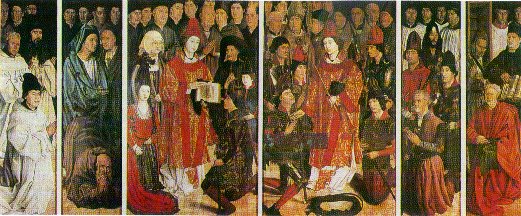 |
|
|
|
Above: the S. Vincent Panels, Nuno Gon�alves' masterpiece, probably painted between 1460-1470. |
|
|
|
In the end of the XV century, the Portuguese artist Nuno Gon�alves painted the famous "Pain�is de S. Vicente de Fora" (in English, the "St. Vincent Panels"). This amazing work of art, one of the best of this period ever found in Europe, consists in 6 pannels. Particularly useful to my point, is that in these six panels all the social classes of the XV century Portuguese society are clearly represented. I will analyse them in detail in this page since they are clearly worth it. |
|
|
|
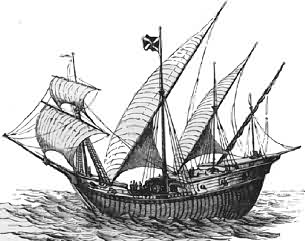 |
|
|
|
Left: A "Portuguese caravel" according to Arthur Kemp (amazingly, this "Portuguese" ship has a Scottish flag).
Below: a model of the real Portuguese caravel. Caravels had two or three lateen (triangular) sails, but they rarely had square sails. Triangular sails allowed sailing against the wind. Only in the later period of the explorations were some square sails added. |
|
|
|
|
|
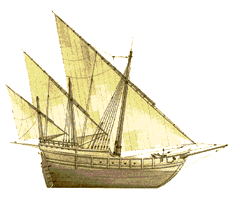 |
|
|
|
|
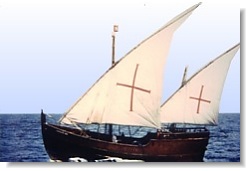 |
|
|
|
|
|
|
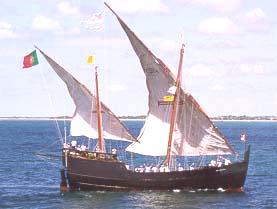 |
|
|
|
|
Top: the Portuguese caravel "Bartolomeu Dias" (currently in display in a South African museum). This was probably the first caravel built since the XVI century, and it was paid by the Portuguese community in South Africa, as a part of the celebrations of Bartolomeu Dias' 1488 epic voyage.
Right: the Portuguese caravel "Boa Esperan�a", built in 1998. The extreme navegability of this ship was proven when a Portuguese crew sailed across the Atlantic Ocean as a part of the 500 years celebrations of the discovery of Brazil by Pedro �lvares Cabral. |
|
|
|
|
|
|
The caravel was not particularly suited for oceanic sailing. It was useful to explore because it required a very small crew (7 or 8 people only) and because of the lateen sail that allowed tackling the wind. The caravel was actually a small ship with a very small cargo capacity. |
|
|
|
To sail to India, the Portuguese started using another type of ship: the nau. A nau was similar to the Spanish galleon. Here is the nau S. Gabriel, where Vasco da Gama sailed. |
|
|
|
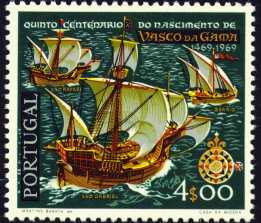 |
|
|
|
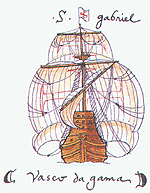 |
|
|
|
|
|
Arthur Kemp writes |
|
|
|
Secondly, Portugal imported masses of Black slaves into its own territory, starting in 1441, when the first ship full of Black slaves arrived in Lisbon. Black slaves continued to be imported in such large numbers that by 1550, they officially made up ten percent of the population of Portugal. |
|
|
|
There were no social restrictions on the Black population, and intermarriage was as frequent as not. |
|
|
|
The truth |
|
|
|
This is obviously a lie and I will show why. From the book Transatlantic Slavery: The Dark Passage, by Jonathan Kuzma Gill (thanks to Teuton) |
|
|
|
I have prepared a table which displays cumulative figures of the Negroes which entered slave-owning European nations. I must stress again that these figures are not for any given time, but for all times taken together. The figures are my own estimations, but, having studied this subject for 40 years, I believe I am more than qualified to render an opinion: |
|
|
|
Portugal
Spain
Italy
France
England
Netherlands
Germany |
|
35,000-40,000
40,000-60,000
35,000-50,000
15,000-20,000
100,000
10,000
10,000-15,000 |
|
|
|
Portugal began this trade in Europe, and were the first nation to import a large number of Negroes. There was a time, in about anno Domini 1550, when Lisbon and Evora were 10 percent Negro, with the entire nation being about 1 percent so. However, the figures are misleading if not properly explained. The vast majority of Negroes in Portugal were subsequently shipped elsewhere, to Brazil primarily. The remaining ones were used as household servants and farm laborers, with many perishing in the latter capacity. There is much talk of the disproportionate absorption of Negroes into the Portuguese populace, but this is simply untrue. Certainly there was some, but no more than in the other nations discussed here, and their contribution to the overall ancestry of the Portuguese people, as well as the Spanish, Italian, French, English, Dutch and German peoples, is virtually nil. The European tended to view the Negro with suspicion and was not likely to engage in extra-curricular activity with him.
Spain and Italy generally made use of Negroes in the same way their Portuguese brethren did, with Spain deporting many of theirs to their overseas colonies. As an interesting sidenote, fully ten percent of Argentina's population consisted of Negroes and Mulattos in the early to middle years of the XIX century. What became of this population, considering how now there are virtually no Negroes there, is a matter of intense debate, but not for this author. It is known that upon their being freed, many fled the nation while others perished; some absorption took place, but again not enough for the Negro to make up a substantial part of the Argentines' ancestry.
In France, the Netherlands, England and Germany the Negro was used mainly as a household attendant. In many cases Negroes were given charge of their Masters' children. Interestingly, France during the XVI and XVII centuries explicitly stated that slavery did not exist on French soil. This was of course a falsehood used to deceive the working classes. In a few cases, however, Negroes fought for their freedom and won. Negroes, both slave and free, were treated surprisingly well in France. In Germany, they were concentrated mostly in cities and in the Hesse district. In the Netherlands, they were to be found mainly in Amsterdam and Rotterdam. In England, they were in most of the large cities and a number of smaller ones, with London having a 20,000 Negro population during the XVII and XVIII centuries. It is known that some of the Negroes in England were absorbed into the lower-class White populations, but again, as mentioned previously, this did not occur disproportionately anywhere in Europe. The overseas colonies, however, are another matter entirely, and we will now begin our discussion of that topic.(...) |
|
|
|
From this book we can conclude that Portugal imported less than 40.000 black slaves. In 1550, they made up 10% of the population of the cities of Lisbon and Evora, not of the country. As everyone should know, the society of the XVI century was agrarian and rural, meaning that the vast majority of the population was living in villages, not in the cities. Most of those villagers never saw a black person during their lifetime. |
|
|
|
In 1541, England had about only 2.8 million people (according to John Munro of the University of Toronto's Department of Economics). The Portuguese population for the same period of time can be calculated around 1.8 - 2 million people (Mattoso, Jos�, Hist�ria de Portugal volume 3, page 202) . Lisbon's population was around 100.000 (and growing), but the second largest city was Oporto with only about 20.000 people, which indicates that Lisbon was the by far the largest city in the kingdom. |
|
|
|
Assuming that there were 40.000 black slaves imported and that the Portuguese population was around 1.8 million people (the worst possible scenario), the percentage of Africans in the Portuguese population would be of 2.22% only, which is nothing close to Arthur Kemp's 10% estimate (based solely on the population in Lisbon, which was the richest city in Portugal and therefore more likely to have a larger number of slaves than the rest of the realm).�If we assume that there were 35.000 black slaves imported and that the Portuguese population was of 2 million people we get the number of 1,75%. The real value should have been around 2%. |
|
|
|
Now, the black males would never be able to marry a white Portuguese woman. Not only it would go against society, but it would have no social benefit whatsoever for a woman to marry a slave. It simply didn't happen, so the importance of the Negroid contribution would be closer to 1% instead. |
|
|
|
Not only that, but black slaves didn't have access to the same medical care and nutrition that their white masters (or most of the rest of the population) could afford. It wouldn't be surprising if one of the reasons why so many slaves were imported, was simply because they kept dying from excessive labour, disease malnutrition, and seasoning. Further more, not every single black woman was raped by their white masters. Portugal wasn't Brazil, and the slave owners had a lot less liberty to do what they wanted to do with their slaves. For starters, they had their wives close by, keeping an eye on them. But lets assume that the slaves were getting great healthy meals, that they could rest on Sundays, that they had access to the best surgeons and everything else, the fact remains: 2% is a lot different from 10%. How did Arthur Kemp get to that result? |
|
|
|
Well frankly, I don't know. He can't even use the argument that black women were having more children than the white females. The truth is that in the XVI century there weren't any birth control methods. Women simply had all the children they had to have - until they either became sterile (from old age) or until they died while delivering, which was probably how most young women died. Portuguese women with 14 or 15 young infants were not uncommon until the beginning of the 20th century. |
|
|
|
Now the interesting thing is that England, as an example, with a population of about 2.8 million people in 1541, imported about 100.000 slaves (roughly about 3,6% of the English population). This is almost twice the percentage due to Portugal, and yet there is no mention to black ancestry in England. |
|
|
|
In fact, there are historical archives that show how large the number of Black slaves in England was during queen Elizabeth's reign. In 1596, queen Elizabeth sent an open letter to the Lord mayor of London and to the mayors and sheriffs of other towns:
"Her Majesty understanding that several Blackamoors have lately been brought to this realm, of which kind of people there are already too many here".
In 1601 she proclaimed herself "highly discontented to understand that the great numbers of negars and Blackamoors which (...) are crept into this realm".
There are no reasons to suspect that any possible later atemps succeeded where the previous ones had failed. |
|
|
|
Spain for instance, had some 9 million inhabitants by the year 1580 [according to "La poblaci�n espa�ola al comienzo de los tiempos modernos", Anuario de Estudios Medievales VII, Barcelona 1970-71]. Jonathan Kuzma Gill estimated the number of African slaves in Spain somewhere between 40.000-60.000 individuals. The worst possible percentage for Spain would be 0,67% of the population. Once again, Spain is mentioned as a racially mixed country, while England isn't. If this isn't lack of coherence, I don't know what is. |
|
|
|
To conclude: Arthur Kemp says that the black slaves made up 10% of the Portuguese population (which makes around 200.000 men and women), and that they were imported to replace the Portuguese men fighting in India and in Brazil. One wonders why, considering that there were only 40.000 portuguese controlling the Indian spices trade monopoly in 1530, and that by 1600 there were only 25.000 portuguese settlers in Brazil. Why import 200.000 slaves to replace little more than 40.000 men, considering that the colonisation of Brazil began in 1530? I don't know, but I am sure Arthur Kemp's imagination will provide us the answer. |
|
|
|
Chapter 22 Part II (b)
Refuting Kemp |
|






